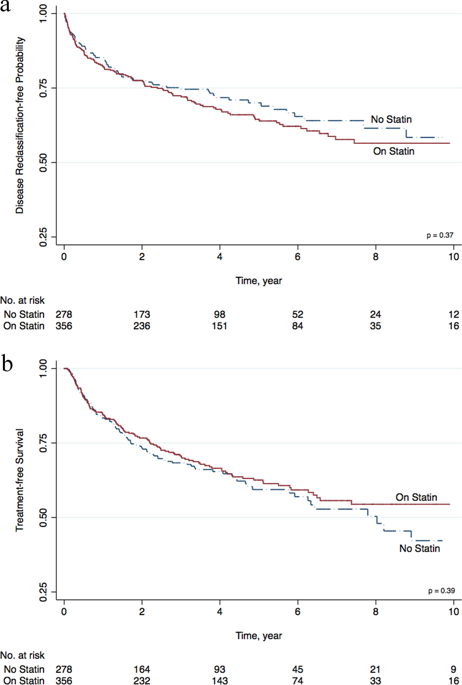Prostate Cancer and Prostatic Diseases ( IF 4.8 ) Pub Date : 2019-04-17 , DOI: 10.1038/s41391-019-0147-0 Yaw A Nyame 1 , Lamont Wilkins 1 , Daniel J Greene 1 , Vishnu Ganesan 1 , Charles Dai 1 , Nima Almassi 1 , Andrew J Stephenson 1 , Michael Gong 1 , Ryan Berglund 1 , Eric A Klein 1

|
Background
This study aims to assess the effect of statin therapy on outcomes among men managed with active surveillance.
Methods
This is a retrospective cohort study evaluating 635 men managed with active surveillance from 2005 to 2015 at a large, academic medical center. The primary endpoints of analyses are disease reclassification (i.e., change in volume or grade of cancer on subsequent biopsies after diagnosis), progression to definitive therapy with curative intent (i.e., surgery or radiotherapy), and surveillance failure—defined as the development of either biochemical failure after definitive therapy, metastases, or prostate cancer-specific mortality—among statin and non-statin users. Secondary analyses were performed to assess the effect of statin use on outcomes among men who progressed to definitive treatment.
Results
Three hundred fifty-six (56.1%) patients in the cohort were on statin therapy at the initiation of surveillance. The median age was 66.7 and 63.3 years among statin and non-statin users, respectively. On univariate analysis, there were no differences in the rates of disease reclassification, progression to definitive treatment, and surveillance failure between the statin and non-statin users in the cohort (all p > 0.05). There was no difference in the rate of biochemical failure among men who progressed to definitive therapy when stratified by statin use (p = 0.89). Pathologic data were available for 105 men who progressed to radical prostatectomy while on surveillance at our institution. Duration of statin use (months) was inversely correlated with adverse pathology for radical prostatectomy on both univariate (OR: 0.99; 95% CI 0.98, 0.99; p = 0.03) and multivariate analysis (OR: 0.98; 95% CI 0.97, 0.99; p = 0.02).
Conclusion
Statin use was not associated with any clinical benefit with regard to disease reclassification, progression to definitive treatment, or surveillance failure among men selecting active surveillance at our institution. There was a 2% decrease in the odds of adverse pathology for each month of statin use among the men who progressed to radical prostatectomy while on active surveillance, but it is unclear at this time if this association has any durable impact on surveillance outcomes among men with favorable risk prostate cancer.
中文翻译:

在选择主动监测局部前列腺癌的男性中评估他汀类药物使用与肿瘤学结果之间的关系。
背景
本研究旨在评估他汀类药物治疗对接受主动监测的男性结局的影响。
方法
这是一项回顾性队列研究,评估了 2005 年至 2015 年在一家大型学术医疗中心接受主动监测管理的 635 名男性。分析的主要终点是疾病重新分类(即,诊断后后续活检中癌症的体积或分级发生变化)、进展为具有治愈目的的确定性治疗(即手术或放疗),以及监测失败——定义为任何一种疾病的发展明确治疗后的生化失败、转移或前列腺癌特异性死亡率——在他汀类药物和非他汀类药物使用者中。进行二次分析以评估他汀类药物的使用对进展到最终治疗的男性结局的影响。
结果
队列中的 356 名 (56.1%) 患者在监测开始时接受了他汀类药物治疗。他汀类药物和非他汀类药物使用者的中位年龄分别为 66.7 岁和 63.3 岁。在单变量分析中,队列中他汀类药物和非他汀类药物使用者的疾病重新分类率、进展至确定性治疗和监测失败率没有差异(所有p > 0.05)。当按他汀类药物使用分层时,进展到确定性治疗的男性的生化失败率没有差异(p = 0.89)。在我们机构的监测中,105 名进展为根治性前列腺切除术的男性可获得病理数据。在单变量(OR:0.99;95% CI 0.98,0.99;p = 0.03)和多变量分析(OR:0.98;95% CI 0.97,0.99;p = 0.02)。
结论
在我们机构选择主动监测的男性中,他汀类药物的使用与疾病重新分类、进展至明确治疗或监测失败的任何临床益处无关。在积极监测期间进展为根治性前列腺切除术的男性中,每个月使用他汀类药物的不良病理几率降低 2%,但目前尚不清楚这种关联是否对男性监测结果有任何持久影响具有有利的风险前列腺癌。

























 京公网安备 11010802027423号
京公网安备 11010802027423号